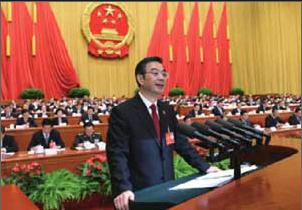On the Frontlines of Judicial Reform
2016-04-08ByWangHairong
By+Wang+Hairong

Lu Guoyi, deputy head of Beijings Fangshan District, went on trial at the Beijing No.4 Intermediate Peoples Court on November 25, 2015, not for any personal wrongdoing, but on behalf of the defendant —the district government. The intermediate court, established at the end of 2014, was created as a pilot for judicial reform.
“The Beijing No.4 Intermediate Peoples Court pushes forward administrative litigation, where staff of administrative organs have appeared in courts in 100 percent of cases, substantially contributing to the settlement of administrative disputes,” said Zhou Qiang, President of Chinas Supreme Peoples Court(SPC), in the work report he delivered to the National Peoples Congress on March 14 in Beijings Great Hall of the People.
Previously, administrative cases in the various districts of the capital city were first heard at local district courts. Now, first-instance hearings of such cases are held in the No.4 Intermediate Court, which is designed as a cross-district court in Beijing to avoid intervention—and therefore a disruption of impartiality—from district government officials.
The court is already busy handling local cases. Recently, a plaintiff surnamed Meng, who ran an otter rabbit farm in Shuangmo Village of Changgou Town, accused the Fangshan District Government for forcefully demolishing his farm.
Meng rents the plot of land to operate the farm from another plaintiff, surnamed Zhang, who is a resident of Shuangmo Village. On the morning of August 5, 2015, the farm was torn down by the District Flood and Drought Control Headquarters with an administrative enforcement decision saying that the farm blocks a river course for flood discharge. Meng believed that the district government violated his property rights and demanded compensation of 1.25 million yuan ($191,750).
Zhang stated that he contracted the plot of land from the village committee. On July 22, 2015, he received a notice from the Fangshan District Flood and Drought Control Headquarters, requiring him to move the farm before July 27 of the same year—just five days later—to clear the river course of barriers obstructing flood discharge. Zhang believed that the farm did not occupy the course of any river, so he requested administrative reconsideration. On August 5, 2015, he received the administrative enforcement decision. Zhang claimed that the decision was invalid and requested the court to revoke it, but the farm was already destroyed.
The defendant, the Fangshan District Government, believed that according to the district flood control plan made in 2006, the otter rabbit farm was located in the river course of the Nanquanshui River, so in the case of a flood, it would endanger the life and property of people living on the banks. The defendant claimed that the forceful demolishment was legal. At the time of writing, a final verdict on the case had yet to be announced.
Spearheading reform
The case is one of the typical cases the intermediate court has received in its pilot stage. Wu Zaicun, President of the No.4 Court, explained that administrative cases have mostly involved land expropriation, housing demolition and government information disclosure. He said that previously, only a small percentage of such cases were accepted by courts, and government departments seldom lost such cases.
Now, people who want to sue district-level governments in Beijing can file their cases with the No.4 Intermediate Court, which is administered by the Beijing Municipal Government instead of the district-level government. “Putting administrative cases into cross-district courts will extricate courts from intervention, so that the general public can stand on equal footing with government departments to push for resolution of administrative disputes,” Wu stated.
To protect peoples litigation rights, the No.4 Intermediate Court implemented a casefiling registration system from its inception. That is to say that the court accepts a case in its jurisdiction as long as the required documents are submitted.
On May 1, 2015, the SPC reformed the case acceptance method, changing the case-filing review system into a case-filing registration system. Under the previous system, a case was only accepted after it passed a review. This reform has made it easier for people to file cases and has led to a significant increase in the number of cases accepted. According to a white paper titled Judicial Reform of Chinese Courts released by the SPC on February 29, 2016, from May to December last year, courts across the country had accepted nearly 10 million cases, up nearly 30 percent year on year.
In addition, in 2015, the No.4 Intermediate Court of Beijing accepted 1,397 administrative cases, almost seven fold the number of such cases received in all Beijing courts in 2014, said Wu at a press conference held on December 30, 2015, to commemorate the one year anniversary of the establishment of the cross-district court. Wu said that the acceptance rate of administrative cases reached 88 percent in 2015, much higher than the 2014 average rate of 32 percent in Beijing, while the percentage of cases in which district-level governments lost had increased by six percentage points.
No external interference
Since 2013, the SPC has rolled out a slew of pioneering reform measures, said Li Shaoping, Vice President of the SPC, at a press conference on February 29. He said that judicial reform is a vital component of the deepening reform in China and is important for advancing law-based governance. Li said that currently, the central leadership has adopted four important reform measures, including: improving the classified management of judicial personnel; the judicial accountability system; professional guaranty for judicial personnel; and pushing forward the unified management of personnel, funds and properties of local courts below the provincial level. By the end of 2015, a total of 417 courts across the country had been chosen to pilot these measures in three batches, he said.
According to the white paper on judicial reform, institutional adjustments have been made to ensure the independence and impartial exercise of judicial power by courts. In order to detach courts from local interests and interference, the SPC had decided to put the management of personnel, funds and properties of lower-level courts under provincial-level governments rather than district- or county-level governments. The SPC has also established two circuit tribunals: the First Circuit Tribunal in Shenzhen, south Chinas Guangdong Province; and the Second Circuit Tribunal in Shenyang, capital of northeast Chinas Liaoning Province. The circuit tribunals, on behalf of the SPC, adjudicate major administrative cases and crossadministrative-division civil and commercial cases respectively in south and northeast China.
To prevent external intervention in the judicial system, the SPC requires courts at various levels to set up special databases to record inquiries about specific cases by any organization or individual outside the peoples courts. In addition, special databases should be set up to record interference by any insider of the judicial organs other than those authorized to handle respective cases.
According to Wu, although some leaders of Beijings district-level governments have visited the No.4 Intermediate Court to attend seminars and exchange ideas in 2015, none of them interfered with a specific case. “We welcome government departments to come to discuss how to promote law-based governance. Yet there is a rule, which is no discussion of specific cases, and questions about specific cases can only be raised in court.”
Holding judges responsible
The responsibility system is an institutional cornerstone for judicial impartiality. In September 2015, the SPC released a guideline for it, promoting the principle of “letting the adjudicator judge and be accountable,”Li said. Personnel reform is implemented in courts to improve professionalism. Court personnel are categorized into judges, trial support personnel and judicial administration personnel and managed differently.
“Eighty five percent of a courts manpower should then be allocated to the frontline to handle cases,” Li said.
Courts are required to select and appoint judges through open, fair and impartial procedures so that only those with a high degree of integrity, experience and expertise are chosen. In a court piloting judicial reform initiatives, the number of judges is restricted by a quota set according to local social and economic conditions and case load. A judge is to be assisted by a certain number of trial personnel including assistants and court clerks.
The SPC makes clear that the president, vice president and presiding judge shall no longer approve, verify, sign or issue the judgment for any case that they have not directly participated in, except for cases discussed and decided by an adjudication committee. The president, vice presidents and adjudication committee members are now encouraged to directly hear complicated cases.
According to the white paper on judicial reform, all 873 presidents and presiding judges from Beijing courts at three levels have appeared in court to handle cases so far, and the number of cases handled by them accounts for 15.5 percent of the cases closed by all the judges from Beijing courts in 2015. In the No.4 Intermediate Court, the president and vice presidents hear cases directly. The first case heard by the court in February 2015 was adjudicated by President Wu, while the afore-mentioned case concerning the Fangshan District Government was adjudicated by Vice President Cheng Hu.
Data from the court show that currently, judges account for 33 percent of the courts personnel, and trial support and administration personnel respectively account for 52 percent and 15 percent of the total.
In the No.4 Intermediate Court, a case is usually adjudicated by a team consisting of three judges, three assistant judges and two court clerks. The document released by the SPC on September 15, 2015, makes clear that judges shall be responsible for the case handling quality within their scope of duties. It states that a judge, who intentionally violates the laws during adjudicative procedures or renders an erroneous ruling by gross negligence, which causes serious consequences, shall assume the liabilities of illegal adjudication.
